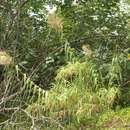en
names in breadcrumbs


Chăng-kō̤ Mìng-dĕ̤ng-ngṳ̄ Háng-cê gì bēng-buōng. / 參考閩東語漢字其版本。
Găng-mè̤ng (菅芒)[1], sê siŏh-cṳ̄ng dŏ̤-nièng-sĕng chāu-buōng sĭk-ŭk. Gṳ̆ng-câung kĕng iā huák-dăk. Gāng iā gà̤ng, chiông dé̤ṳk siŏh-iông, ô 2 mī gáu 4 mī cō̤-iêu.[2]
Chăng-kō̤ Mìng-dĕ̤ng-ngṳ̄ Háng-cê gì bēng-buōng. / 參考閩東語漢字其版本。
Găng-mè̤ng (菅芒), sê siŏh-cṳ̄ng dŏ̤-nièng-sĕng chāu-buōng sĭk-ŭk. Gṳ̆ng-câung kĕng iā huák-dăk. Gāng iā gà̤ng, chiông dé̤ṳk siŏh-iông, ô 2 mī gáu 4 mī cō̤-iêu.
Ko e kaho ko e faʻahinga mohuku ia, tupu ʻi he vai melie pe ofi ki ai. ʻOku lava aʻu mita ʻe 3 ki ʻolunga. Ko e fuʻu ʻakau tuʻufonua.
vakai foki ki he kaho alu
Ko e kaho ko e faʻahinga mohuku ia, tupu ʻi he vai melie pe ofi ki ai. ʻOku lava aʻu mita ʻe 3 ki ʻolunga. Ko e fuʻu ʻakau tuʻufonua.
Miscanthus floridulus, the Pacific Island silvergrass,[2] is a species of perennial grass in the family Poaceae.
Miscanthus floridulus is native to parts of eastern and southeastern Asia and the Pacific islands.
It is native to southern China, Laos, Vietnam, Myanmar, and Peninsular Malaysia on the Asian mainland, and to Japan, the Ryukyu Islands, Taiwan, Hainan, the Philippines, Sumatra, Java, the Lesser Sunda Islands, Sulawesi, Maluku, and New Guinea, the Bismarck Archipelago, Solomon Islands, Vanuatu, New Caledonia, and Fiji, as well as parts of Micronesia (Caroline Islands, Marshall Islands, and Gilbert Islands) and Polynesia (Cook Islands, Marquesas Islands, Niue, Samoan Islands, Society Islands, Tonga, Tuamotu Archipelago, Tubuai Islands, and Wallis and Futuna).[1]
It has been introduced to Hawaii and the Mariana Islands, and to Arkansas and Missouri in the mainland United States.[1]
In the Highlands Region of Papua New Guinea, this grass is locally known as pit pit grass, and grows naturally. The local communities use the stem of this grass for several purposes. The matured stem is used to make fences around gardens. It is also used to construct the outer wall of traditional houses. The third important use is that remote households burn dried stems to light their houses. Also, children who walk to school carry torches from the burning stem of this grass until they reach their destination. A torch is about 1–2 m (3.3–6.6 ft) long and it takes quite a while to burn it down. The walking distance is long where the children start their journey as early as 5 am.
Miscanthus floridulus, the Pacific Island silvergrass, is a species of perennial grass in the family Poaceae.
Miscanthus floridulus, aussi appelé roseau de Chine[3], est une espèce de plantes monocotylédones de la famille des Poaceae.
L'espèce se présente comme une grande herbe vivace en touffes raides[3].
Les inflorescences sont de grandes panicules plumeuses pyramidales, dressées et soyeuses[3].
Originaire de Chine et du Japon, cette espèce a été introduite dans d'autres zones géographiques, notamment la Polynésie et la Nouvelle-Calédonie[3], où elle pourrait s'avérer envahissante (statut incertain)[4].
Cette espèce a été décrite en 1824 sous le basionyme de Saccharum floridulum par le botaniste français Jacques-Julien Houtou de La Billardière (1755-1834), puis recombinée dans le genre Miscanthus en 1901 par les botanistes allemands Karl Moritz Schumann (1851-1904) et Karl Lauterbach (1864-1937), à la suite des travaux de leur homologue Otto Warburg (1859-1938)[5].
L'épithète spécifique floridulus signifie « très florifère »[6].
Miscanthus floridulus, aussi appelé roseau de Chine, est une espèce de plantes monocotylédones de la famille des Poaceae.
Miscanthus floridulus là một loài thực vật có hoa trong họ Hòa thảo. Loài này được (Labill.) Warb. ex K.Schum. & Lauterb. mô tả khoa học đầu tiên năm 1900.[1]
Miscanthus floridulus là một loài thực vật có hoa trong họ Hòa thảo. Loài này được (Labill.) Warb. ex K.Schum. & Lauterb. mô tả khoa học đầu tiên năm 1900.
五節芒(Miscanthus floridulus)又名菅蓁、芒草、菅芒花,是台灣及香港常見的多年生草本植物。
葉背綠色,葉下無白粉,葉緣有鋸齒容易割傷皮膚。雌雄同株,可高達4公尺。花期4至7月,花初期為淡黃色、成熟時呈黃褐色,圓錐花序,小穗長2至4公釐。果實呈橢圓狀。
零星分佈在台灣陽明山。古時台灣賽夏族使用於矮靈祭場裡,鋪設在祭場中以驅邪求平安。莖部嫩心可作食用,亦是台灣早期重要的建築材料,葉柄可編織成屋牆,芒葉能鋪蓋屋頂。